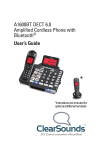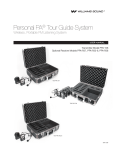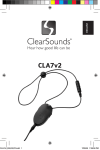Download BST-25 - Comtek
Transcript
BST-25 / TV 5-6 OPERATOR’S MANUAL (76-88 MHz) Synthesized Base Station Transmitter 357 West 2700 South • Salt Lake City, Utah 84115 • Phone: (800) 496-3463 • Fax: (801) 484-6906 • www.comtek.com INTRODUCTION BST-25 / TV 5-6 Synthesized Base Station Transmitter T he BST-25 is a low power auxiliary base station transmitter designed to operate under Part 74 of the FCC Regulations in the unused TV channel 5 and TV channel 6 spectrum (76.2 to 87.8 MHz). This transmitter, along with a personal receiver, is used in a TV production studio for IFB and talent cueing. It may also be used on remote location from an ENG truck for the same application. In motion picture production, the BST-25 is used as a low power auxiliary base station transmitter located on site with the sound recording equipment. Directors, boom-operators, and others may receive, with a personal receiver and headphone, the high fidelity transmission from the BST-25 to monitor sound track audio being recorded. This transmission, or “Confidence Channel”, may also be used as an IFB for talent or crew members. Page 1 OPERATING INSTRUCTIONS Equipment Placement If the BST-25 base station is to be rack mounted, a remote antenna must be used. The base station should be mounted away from equipment that uses large power transformers to reduce 60 Hz hum possibilities. If the base station is to be used outside of a traditional rackmounted environment, the screw-in whip antenna should be free of any metallic objects when fully extended. Special Note: When using the base station in close proximity to other audio equipment, ensure that the audio equipment is not susceptible to RF interference. This can be accomplished by temporarily installing the base station as per above, and then while the base station is operating, checking all audio outputs for uncharacteristic noise. If a problem is found, move the base station or the remote antenna as far as possible from the affected equipment. Should you continue to have problems, contact COMTEK’s application engineering department for assistance. Remote Antenna When the base station is rack-mounted or when greater system range is required, a remote antenna should be used. For vehicle installation, a 1/4 wave roof-mount (MO-1/4 wave or MAG-1/4 wave) should be used. For field or studio applications, the COMTEK “Phase Right Antenna” (PRA-L TV 5-6) is an easy-to-use, high performance, omni antenna. For high gain directional yagi type antennas and custom antennas, contact COMTEK’s application engineering department for assistance. Please note: Do not install screw-in whip antenna if remote antenna is used. Page 2 Power Requirements The BST-25 base station is designed to be powered by 12 volts DC. A power adaptor is furnished for use with standard 110V AC. The on/off switch on the front panel of the base station turns on the transmitter. Audio Input Connections The base station transmitter has facilities for audio input from a mic, line, or speaker level source. The mic/line level audio input is a transformer balanced input and requires a standard XLR-3 male connector. Unbalanced input is accomplished by shorting pin-3 to pin-1 (audio ground), leaving pin-2 as the audio source. Please note: when unbalanced input is used, it is recommended that all audio input cables be kept as short as possible. Set-up a. Select an appropriate location for the base station in accordance with “Equipment Placement” instructions. b. Set the “MIC/LINE” switch, located on the back of the base station transmitter, to the appropriate position: "MIC" position for low impedance microphones or “LINE” position for line level feed. c. Connect the audio source or microphone to the base station using the appropriate input. Be sure to set the audio input level adjustment on the base station to its full counterclockwise position. Page 3 OPERATING INSTRUCTIONS (continued) d. Plug the adaptor into a standard AC outlet and plug the power connector into the DC input jack of the transmitter. Turn the display switch on the front of the transmitter "ON" to allow monitoring of the transmitter frequency. Turn the main power switch on the front of the base station to the "ON" position. The front display should now be illuminated. e. Mount the telescoping whip antenna in the hole on top of the base station rotating it clockwise until it is firmly seated. Extend the antenna completely. During normal operation the antenna indicator should not flash. Turn on the transmitter and verify that the antenna indicator is not flashing. If the antenna indicator is flashing, shorten the telescoping whip antenna by 2 inches and again check the indicator. Continue this procedure until the indicator remains off. If you experience trouble, please contact COMTEK's application engineering department for assistance. If you are using an external type antenna, DO NOT install the telescoping antenna. Instead, connect the coaxial feed line for the external antenna to the external antenna port on the back of the BST-25. Note: For optimum performance when using the telescoping whip antenna, the transmitter should be placed on a large metallic surface. Adjustment of antenna length for a “No Flash” condition on antenna indicator will ensure maximum radiation. Page 4 Audio Adjustments In order to ensure the highest possible transmission fidelity, the transmitter must be modulating at least 50% with normal speech (-3 dB on the VU meter). This adjustment is made in the following manner: a. Ensure that the audio source has been optimized for best signal-to-noise ratio. b. The “MIC/LINE” switch located at the back of the transmitter should be switched to the appropriate setting: "MIC" for mic level or weak line level input; “LINE” level for line level input. c. The “LEVEL” control on the back of the base station should be set fully counterclockwise and then, while normal program information is present, slowly rotate the “LEVEL” control clockwise until the VU meter on the front panel begins to deflect. Adjustment should be made so that normal speech or music deflects the meter mid-scale. Only very loud speech or music should deflect the VU meter full-scale. Frequency Selection ANT IMPORT The BST-25 base station transmitter has the ability to operate on one of 119 preset channels between 76.200 MHz and 87.800 MHz (TV channel 5 and TV channel 6). Channels are designated by both frequency and channel number. Channels which operate in the TV 5 spectrum are prefixed with a 5 (5-50 is 81.100 MHz), channels operating in the TV 6 spectrum are prefixed with a 6 (6-50 is 87.100 MHz). This channel rastering makes it easy to determine which TV band you are operating on. Page 5 OPERATING INSTRUCTIONS (continued) If you are using this transmitter in a area which does not have a TV station operating on channel 5, you can use one of the channels in the TV 5 range. Conversely, if the area does not have a station on TV 6, you can operate on one of the TV 6 channels. Note: It is unlawful to operate this transmitter in a band that is already occupied by a TV station. After you have determined the channel on which you are going to operate, use the “TUNING” button to select the channel that you have chosen. See charts on pages 10 and 11 for preset selectable frequencies. Multiple Channel Operation Simultaneous operation of more than two channels requires coordination of the frequencies that are used to avoid intermodulation interference. To avoid this type of interference, select frequencies from one of the standard groups (see frequency group charts on page 11), or use COMTEK’s frequency selection guide software to determine appropriate frequencies. Contact COMTEK to obtain a free copy of the frequency selection software or download it off the web at www.comtek.com/frequency.html Test Tone The BST-25 base station transmitter has an internal 400 Hz source which is transmitted when the “TONE” switch is enabled. This source is intended to be used to make technical adjustments and to verify the operation of the system. Under normal operation the “TONE” switch should be disabled. Page 6 Speech EQ On the back of the transmitter there is a switch labeled “EQ”. With this function enabled (switch up), the audio dynamics and frequency response are processed to improve intelligibility of speech. If the primary audio source is going to be speech, you should enable this processing! If the main audio source is going to include music information, you should disable it. You may want to experiment to determine which position sounds most pleasing with the program source you intend to use. Display On and Off The digital display can be turned on or off using the “DISPLAY” switch. Disabling the display reduces the current consumption of the transmitter for battery operation. In environments where the display could be distracting, disabling the display may also be appropriate. When the display is disabled, the tuning controls are also disabled, ensuring the transmitter frequency is not changed inadvertently. With the display disabled, one segment is turned on as a power indicator. Additionally, the “LOCK OUT” indicator is illuminated indicating the tuning is disabled. The VU meter and the “ANTENNA” indicator are unaffected. Lock Out After the transmitting frequency has been determined, the transmitter tuning function can be disabled with the “LOCK OUT” switch on the back of the transmitter. This ensures that the transmitter operating frequency is not inadvertently changed. The “LOCK OUT” indicator (above the first numeric digit on the display) will illuminate indicating that the tuning has been disabled. When rack-mounting the transmitter, this switch must be accessed from behind the rack. This provides added protection from tampering. Page 7 BST-25 FRONT PANEL 1 2 3 4 5 6 7 8 9 1 DISPLAY SWITCH: This switch disables the digital display to conserve current when used with a battery. 2 TONE SWITCH: Enables/disables the internal 400 Hz test tone. 3 TUNING SWITCH: Selects the frequency on which the transmitter will operate. 4 LOCK OUT INDICATOR: Illuminates when the “TUNING” switch is disabled by setting the “LOCK OUT” switch (rear panel) to “ON”. 5 DIGITAL FREQUENCY DISPLAY: Displays the frequency on which the transmitter is operating. 6 ANTENNA INDICATOR: Flashes when the transmitter senses a deficient antenna condition. 7 VU METER: Displays the level of audio being transmitted. Used to adjust the “LEVEL” (rear panel) control. 8 DIGITAL CHANNEL DISPLAY: Displays the channel on which the transmitter is operating. 9 POWER SWITCH: Turns the transmitter on or off. Page 8 BST-25 REAR PANEL 10 11 12 13 14 15 16 10 LOCK OUT SWITCH: Disables the front panel “TUNING” switch, locking the transmitter on one frequency. 11 DC INPUT JACK: Requires 12 VDC at 500 mA source (Pin-1 ground, pin-4 +12 volts). 12 EXTERNAL ANTENNA JACK: BNC connector provides a standard 50 ohm RF output for use with an external antenna. 13 SPEECH ENHANCEMENT SWITCH: Enables and disables speech enhance feature. Enable this function (switch up) for speech, and disable it (switch down) for music. 14 LEVEL CONTROL: This control should be adjusted so that normal audio deflects the VU meter to midscale. 15 BALANCED AUDIO INPUT: Accepts audio from a line level or mic level. For XLR3 or 1/4” TRS phone plug. 16 MIC/LINE SWITCH: Selects the desired audio input sensitivity. Page 9 BST-25 TV CHANNEL 5 FREQUENCY CHART CHANNEL FREQUENCY CHANNEL FREQUENCY 5-1 76.200 MHz 5-31 79.200 MHz 5-2 76.300 MHz 5-32 79.300 MHz 5-3 76.400 MHz 5-33 79.400 MHz 5-4 76.500 MHz 5-34 79.500 MHz 5-5 76.600 MHz 5-35 79.600 MHz 5-6 76.700 MHz 5-36 79.700 MHz 5-7 76.800 MHz 5-37 79.800 MHz 5-8 76.900 MHz 5-38 79.900 MHz 5-9 77.000 MHz 5-39 80.000 MHz 5-10 77.100 MHz 5-40 80.100 MHz 5-11 77.200 MHz 5-41 80.200 MHz 5-12 77.300 MHz 5-42 80.300 MHz 5-13 77.400 MHz 5-43 80.400 MHz 5-14 77.500 MHz 5-44 80.500 MHz 5-15 77.600 MHz 5-45 80.600 MHz 5-16 77.700 MHz 5-46 80.700 MHz 5-17 77.800 MHz 5-47 80.800 MHz 5-18 77.900 MHz 5-48 80.900 MHz 5-19 78.000 MHz 5-49 81.000 MHz 5-20 78.100 MHz 5-50 81.100 MHz 5-21 78.200 MHz 5-51 81.200 MHz 5-22 78.300 MHz 5-52 81.300 MHz 5-23 78.400 MHz 5-53 81.400 MHz 5-24 78.500 MHz 5-54 81.500 MHz 5-25 78.600 MHz 5-55 81.600 MHz 5-26 78.700 MHz 5-56 81.700 MHz 5-27 78.800 MHz 5-57 81.800 MHz 5-28 78.900 MHz 5-58 81.900 MHz 5-29 79.000 MHz 5-59 82.000 MHz 5-30 79.100 MHz TV 5 Audio 81.750 MHz Page 10 BST-25 TV CHANNEL 6 FREQUENCY CHART CHANNEL FREQUENCY CHANNEL FREQUENCY 6-0 82.100 MHz 6-30 85.100 MHz 6-1 82.200 MHz 6-31 85.200 MHz 6-2 82.300 MHz 6-32 85.300 MHz 6-3 82.400 MHz 6-33 85.400 MHz 6-4 82.500 MHz 6-34 85.500 MHz 6-5 82.600 MHz 6-35 85.600 MHz 6-6 82.700 MHz 6-36 85.700 MHz 6-7 82.800 MHz 6-37 85.800 MHz 6-8 82.900 MHz 6-38 85.900 MHz 6-9 83.000 MHz 6-39 86.000 MHz 6-10 83.100 MHz 6-40 86.100 MHz 6-11 83.200 MHz 6-41 86.200 MHz 6-12 83.300 MHz 6-42 86.300 MHz 6-13 83.400 MHz 6-43 86.400 MHz 6-14 83.500 MHz 6-44 86.500 MHz 6-15 83.600 MHz 6-45 86.600 MHz 6-16 83.700 MHz 6-46 86.700 MHz 6-17 83.800 MHz 6-47 86.800 MHz 6-18 83.900 MHz 6-48 86.900 MHz 6-19 84.000 MHz 6-49 87.000 MHz 6-20 84.100 MHz 6-50 87.100 MHz 6-21 84.200 MHz 6-51 87.200 MHz 6-22 84.300 MHz 6-52 87.300 MHz 6-23 84.400 MHz 6-53 87.400 MHz 6-24 84.500 MHz WIDE-BAND CHANNELS (for use with FM tunable receivers) 6-25 84.600 MHz 6-54 87.500 MHz 6-26 84.700 MHz 6-55 87.600 MHz 6-27 84.800 MHz 6-56 87.700 MHz 6-28 84.900 MHz 6-57 87.800 MHz 6-29 85.000 MHz TV 6 Audio 87.750 MHz Page 11 BST-25 BST-25 TV CHANNEL 5 FREQUENCY GROUPS TV CHANNEL 6 FREQUENCY GROUPS GROUP ONE GROUP ONE CHANNEL FREQUENCY CHANNEL FREQUENCY 5-3 5-6 5-10 5-15 5-21 5-34 5-42 5-56 76.400 MHz 76.700 MHz 77.100 MHz 77.600 MHz 78.200 MHz 79.500 MHz 80.300 MHz 81.700 MHz 6-4 6-7 6-9 6-13 6-20 6-30 6-38 6-50 82.500 MHz 82.800 MHz 83.000 MHz 83.400 MHz 84.100 MHz 85.100 MHz 85.900 MHz 87.100 MHz GROUP TWO GROUP TWO CHANNEL FREQUENCY CHANNEL FREQUENCY 5-5 5-7 5-13 5-33 5-38 5-47 5-54 5-57 76.600 MHz 76.800 MHz 77.400 MHz 79.400 MHz 79.900 MHz 80.800 MHz 81.500 MHz 81.800 MHz 6-2 6-5 6-28 6-34 6-42 6-44 6-49 6-53 82.300 MHz 82.600 MHz 84.900 MHz 85.500 MHz 86.300 MHz 86.500 MHz 87.000 MHz 87.400 MHz GROUP THREE GROUP THREE CHANNEL FREQUENCY CHANNEL FREQUENCY 5-2 5-8 5-11 5-16 5-18 5-29 5-41 5-58 76.300 MHz 76.900 MHz 77.200 MHz 77.700 MHz 77.900 MHz 79.000 MHz 80.200 MHz 81.900 MHz 6-1 6-3 6-6 6-10 6-16 6-24 6-36 6-52 82.200 MHz 82.400 MHz 82.700 MHz 83.100 MHz 83.700 MHz 84.500 MHz 85.700 MHz 87.300 MHz Page 12 BST-25 INTERNAL ADJUSTMENTS NOTE: The COMPAND switch must be set to the OFF position for use with “Walkman” FM band type receivers and TV monitors. Must be set to the ON position for use with PR-25 and PR-216/TV 5-6 receivers. Page 13 BST-25 ACCESSORIES Included Accessories 1. C-16 Carrying case 2. BST-25 Operator’s manual 3. TWA-72 Whip antenna 4. BST-25 Base station transmitter 5. AP-12V1 Power adaptor (115 VAC Input) Page 14 BST-25 ACCESSORIES Optional Accessories 1. RDA-2 Remote dipole antenna 2. PRA-5/6 Phase-Right antenna 3. MO-1/4 wave vehicle installation antenna or MO-1/4 wave magnetic mount antenna 4. PRA-B Phase-Right wall mounting bracket 5. RMK 25 Single rack-mount face plate 6. RMK 25-2 Double rack-mount face plate Page 15 BST-25 / TV 5-6 SPECIFICATIONS Audio Inputs: • Mic XLR, 600 ohm balanced -40 dBV (nominal) • Line XLR, 10 k ohm balanced 0 dBV (nominal) Connectors: • XLR-3 Female audio input connector for mic and line input • XLR-4 Male power input 12 volts • BNC type RF output connector Operation Indicators: • LED Bargraph VU Meter displays audio input (modulation) • Two-Digit Alpha Numeric Display shows operating channel • Five-Digit Numeric Display shows operating frequency • Antenna Indicator displays deficient antenna condition • Lock Out Indicator shows tuning has been disabled Antenna: • Telescopic antenna mounts directly into top of transmitter • BNC RF output connector for optional external antenna FCC Compliance: Type Accepted under Part 74 Power Requirements: 12 Volts DC, 300 mA max Frequency Response: 80 Hz to 15 kHz Audio Distortion: Less than 0.5% at 80% modulation Modulation Limiter: Soft compressor type with high (25 dB) linear overload protection, attack time less than 1 ms, recovery time 10 ms Audio Gain Control: Greater than 40 dB Test Tone Generator: 400 Hz 0.05% distortion Frequency Modulation: •10 kHz deviation for narrow band channels, •75 kHz deviation for wide band channels RF Output Power: Set for 50 mW for FCC Part 74 Frequency Stability: Better than 0.002%. digitally synthesized, crystal controlled Operating Frequency: 76.2 to 87.8 MHz Harmonic and Spurious Emissions: Better than 55 dB below carrier Dimensions: 6 1/2" wide x 1 3/4" high x 5 5/8" deep Weight: 44 oz. NOTE: Specifications subject to change without notice. Page 16 WARRANTY AND SERVICE Warranty COMTEK transmitters and receivers are warranted to be free from defects in workmanship and material under normal stand-alone use and conditions for a period of two years from date of original purchase. Items such as headphones, earphones, neckloops, and cords are warranted to be free from defects in workmanship and material for a period of 90 days from the date of original purchase. Batteries are not covered by this warranty. Damage due to abnormal use, extreme conditions, misuse, use of the product as a component of another product, ill treatment and unauthorized modification and repairs are not covered by this warranty. COMTEK is not liable for any consequential or punitive damages arising out of any failure of the equipment to perform as intended. COMTEK shall bear no responsibility or obligation with respect to the manner of use of any equipment sold by it. COMTEK SPECIFICALLY DISCLAIMS AND NEGATES ANY WARRANTY OF MERCHANTABILITY OR FITNESS OF THE PRODUCT FOR A PARTICULAR PURPOSE INCLUDING, WITHOUT LIMITATION, ANY WARRANTY THAT THE USE OF SUCH EQUIPMENT FOR ANY PURPOSE WILL COMPLY WITH APPLICABLE LAWS AND REGULATIONS. Service Policy Warranty repairs must be done by COMTEK. Only factory technicians are authorized to perform warranty service on the BST-25 transmitter. Before returning the BST-25 for service, a Return Authorization Number should be obtained from the service department by calling 1-800-496-3463 or 1-801-466-3463. Return the unit to the factory with the original or comparable packing. COMTEK will pay for insurance and ground return shipping costs in the United States for all warranty service. 357 West 2700 South • Salt Lake City, Utah 84115 • Phone: (800) 496-3463 • Fax: (801) 484-6906 • www.comtek.com E-mail: [email protected]


































